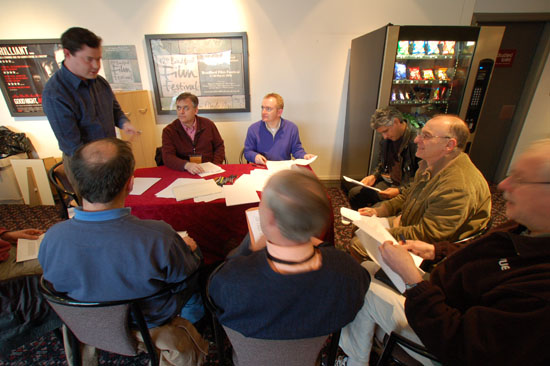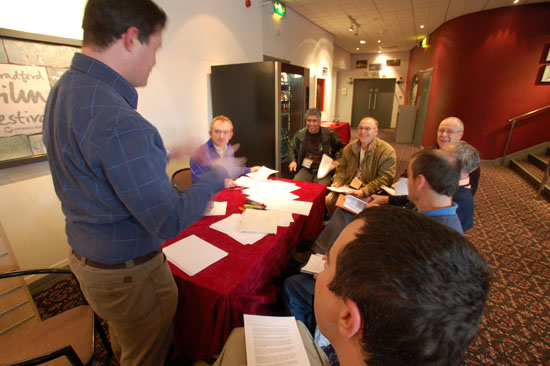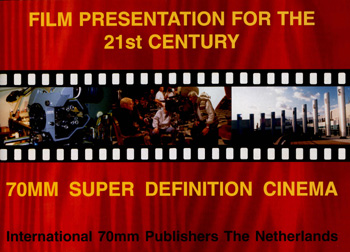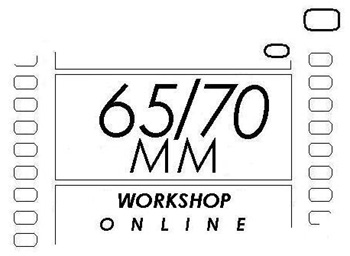Report on the 65/70mm Workshop
|
Read more
at in70mm.com The 70mm Newsletter |
| Written by: Ramon Lamarca Marques & Brian Guckian | Date: 23 March 2006 |
 Brian
Guckian chairing the workshop. Image by Thomas Hauerslev Brian
Guckian chairing the workshop. Image by Thomas HauerslevWorkshop in progress. Around the table were: Ramon Lamarca Marques, Brian Guckian, Ben Wales, Mike Taylor, ?, John Hayes, Siddique Hussain and Adrian Rastrick As stated previously, this workshop is born with the idea of networking people and organisations who are interested in the exhibition of films originated in 65mm and printed on 70mm, a process which shows film qualities at its best. From a recent debate on the film-tech website and other forums on the internet, it is evident that there is an important number of people who like film texture and consider that 65/70 productions could undoubtedly enhance the filmgoer's experience whilst retaining the uniqueness that film brings to cinemas as opposed to the digital medium, which although has got some advantages, is a medium that can be reproduced in the domestic environment. It is important also to try and put film in its place in the history of the 7th art as a very important artistic tool and not as the obsolete technology that some people from the computing world are trying to portray it as. Both Mr Brian Guckian and Mr Ramon Lamarca Marques have participated in the film-tech forum and since they were both attending the Widescreen Weekend, they thought it would be a good opportunity to start gathering ideas and to expose the idea of creating a network of people from anywhere in the world interested in the idea of 65/70 production. Mr Bill Lawrence, Head of Film of the National Theatre of Photography, Film and Television, kindly offered a meeting room for the workshop to be held, but finally it was held next to the box office in Pictureville since the space available there suited the number of people attending it. Mr Brian Guckian and Mr Ramon Lamarca Marques chaired the workshop; their main function was to expose the basic working principles of creating a platform to receive and expose ideas from anyone interested and the attendees showed their interest in such a project. There have been some attempts to bring 65/70 productions back in the past, in that sense this workshop does not differ very much from those attempts and ideas previously used can be reused. Perhaps the main difference with this workshop is its willingness to embrace as many people and organisations as possible to devise a viable future for 65/70 productions. The attendees were (in alphabetical order): Mr. John Hayes, Mr. Siddique Hussan, Mr. Adrian Raistrick, Mr. Paul Rayton, Mr. Mike Taylor and Mr. Ben Wales It should be pointed out that some more people joined the workshop as listeners only and they either left early or did not give their names. Also, Mr. Chris Plaister made a contribution to us earlier in the day. Our thanks to all these, and we hope that they will make a step forward and join us again on-line. The workshop started with the shared opinion that cinemas need to bring back the idea of premium product and excellence in film presentation together with the creation of pictures that emphasize the use of the big canvas of the cinema screen as to differentiate the cinema experience from the nowadays very improved home cinema experience. It was pointed out that IMAX is trying to bring this concept back with its proprietary process IMAX DMR, which blows-up 35mm negative images to be printed onto the IMAX film gauge. The majority of the attendees mentioned that the main problem is that pictures that are designed to look good on television will not look good on the huge IMAX screen since the close-ups that suit the television screen do not suit the IMAX screen, in that sense it was given the example of the IMAX projection of the recent Batman Begins. It was also mentioned that film production in 65mm would benefit not only conventional commercial cinemas but also IMAX screens, since the extra amount of information contained on the 65mm negative would also benefit IMAX presentations since images would not need to be blow-up to such an extent for the IMAX film gauge. |
More
in 70mm reading: White paper - Re-introduction of 70mm Workshop Widescreen Weekend Internet link: To find the thread, go to Film-Tech » Film-Tech Forums » Film Handler's Forum » 70 vs. DC 5 pm / 17:00 Pictureville Sunday 12th March, please gather in the foyer |
 Brian
Guckian chairing the workshop. Image by Thomas Hauerslev Brian
Guckian chairing the workshop. Image by Thomas HauerslevIt was also mentioned the existence of exhibitors like Kinepolis (European cinema group), who commissioned their own 70mm prints of titles in the 1990s (albeit blow-ups from 35mm), for the largest screens in their chain. There are probably exhibitors in all countries that would be very happy to have a premier film product to offer in their biggest screens and 65/70 not only produces beautiful and sharp images but also a warm texture that cannot be experienced at home. Different subjects were discussed in the workshop, especially those subjects mentioned in the white paper produced for the delegates attending the widescreen weekend, which is published on this website. One of these subjects is marketing. A good marketing strategy is nowadays indispensable for any artistic or business process. It was agreed that it was necessary to restore film prestige as an artistic tool amidst all the unfair criticism from some people in the computing and digital world, who fail to understand the artistic value of film as a medium. An example for marketing 65/70 was given. The adverts would use a 70mm big reel and the tag "It won't fit" In different advertisements a man/woman would be seen trying to push this big reel into a portable audio device, into a DVD, into a desktop computer, into a plasma TV, ... This would graphically emphasize the "bigger than life" cinema experience and its difference and incompatibility with domestic technologies. It was pointed out by many of the attendees that since now many people were prepared to watch film on their mobile phone, this was going to be probably the first time in cinema history that a film was going to be seen in the worst conditions possible. In the same subject of marketing it was discussed the importance of branding these film productions in 65/70 and its presentation and this indeed is going to be one of the important aspects of the workshop. The idea of using the number 70 (in reference to the gauge used for the prints) was mentioned. It was said that the 70mm presentation is still linked to very good cinema presentations by many, although some new generations may perceive it as something old. It is important to create a sort of certificate like THX, which gives audiences the confidence of seeing a premium film exhibition. It was also mentioned that a separate listing in newspapers and magazines is paramount for this premiere exhibition to be noticed by audiences. |
|
 Film
Presentation for the 21st Century - 70mm Super Definition Cinema. ISBN:
90-803503-2-X. Published in 1999 by International 70mm Publishers Film
Presentation for the 21st Century - 70mm Super Definition Cinema. ISBN:
90-803503-2-X. Published in 1999 by International 70mm Publishers
Some attendees mentioned that some cinema screens nowadays offer a fast-food type product whilst charging very high admission prices. It was thought that this combination of high prices and poor film presentation has led to the decline in cinema revenue. In that sense, it was mentioned that 2K digital projection was not going to add anything to the current state of cinema presentation, due to the low resolution of the 2K digital projection system when compared to 65/70 productions. Previous attempts to improve both 35mm and 70mm production were mentioned, like Maxivision 48 and Super Dimension 70, and it was considered that the main problem these systems had is its attachment to a single manufacturer of hardware for the projection system. 5/70 projection systems can be provided by several existing companies and this can facilitate the return of this premier system. There was agreement in the need for a holistic approach to the 65/70 rebirth, particularly regarding cinematographers and film directors, to showcase the strengths of the system. There are several films that come to mind, a recent one would be "Memoirs of a Geisha" and one from some years ago could be "The English Patient". There is little point in shooting a film in 65mm, which is only going to use the actors against a blue screen to have all the digital effects rendered afterwards. Technicolor's dye transfer proprietary system was mentioned since it was never used for 70mm prints and many people appreciate its quality, in particular its rendition of blacks and colour saturation and its pictorial qualities. However, it was mentioned that new machinery would be needed and it may not be cost effective. Also, nowadays, Vision Premier stock could give very high quality results using conventional printing. Nevertheless, more investigation can be done on this subject. It was decided to follow up this with Technicolor - someone there may be interested in at least talking about DT for 70mm. Obviously, the role of exhibitors in the workshop is paramount. One of the future actions of the workshop will be to contact exhibitors and find out which of them would support the return of 65/70. It was discussed the role of digital postproduction in the industry. 2K scanning is certainly not a valid option, since the qualities of 65mm would be lost in the bottleneck of the 2K scanning. 4K scanning seems to be the starting point with preferred higher scanning resolution. Ideally, even if postproduction uses a digital intermediate, for those sequences without digital effects, it would be much better to keep film in the film domain to preserve its unique look. The role of filmmakers is of course also very important. It was mentioned, as an example, the fact that Steven Spielberg likes film very much. Film has got an artistic value that should not be dismissed. This is the problem when the issue of film versus digital is discussed just by technological experts, the artistic approach is then missing. The value and importance of film projectionists was also emphasized during the workshop. It escapes no one that digital projection pursues getting away with the role of the projectionists, who have during more that 100 years helped to bring the art of cinema to audiences. A skilled projectionist is very important in the final stage of bringing those images to life. Having a skilled projectionist in the booth not only guarantees perfect projection but also adds the human touch to the film experience. An automatic digital projector can be another element to increase the cold and faceless experience that many cinema theatres offer nowadays. The poor exhibition standards that can be unfortunately experienced in some of today's multiplexes have got not place in 65/70 exhibition. Training and Education for projectionists using 70mm should be a requirement. It was mentioned that in the past there were at least 4 years apprenticeship for film projectionists. As an example of the value that 65/70 has got amongst audiences it was mentioned the fact that classics such as "Lawrence of Arabia" or "2001: a space odyssey" still attract audiences when they are shown on the big screen. Special screenings of such classics could be another option for these cinemas. It is important to educate audiences that whereas many films from the 80s onwards were designed to suit the small TV screen, films from the mid and late 50s, 60s and 70s made full use of the big canvas of the cinema screen for dramatic purposes and on the big screen is when they show all of their artistic values. Distributors should come to understand that this is a specialised product, which should not get the fast-food marketing approach that so many films get today. It is not about just the first weekend revenue, it is about a product that will look substantially better on the big screen on the first week, the second week, the second month, and for many years to come. Some attendees mentioned the "sleeping assets" of great many 70mm dual machines, which are now just used for 35mm. When 70mm projection was abandoned, only the mag[netic, ed] penthouses were removed. There are lots of old machines out there - two crates full of DP70s in Miami - one multiplex recently installed 12 DP70s in US because the owner likes the machines. In the field of sound, it was mentioned DTS as an ideal company to approach, since they have always supported digital sound for 70mm. The return of the 5 channels of stereophonic sound behind the screen is a very important point to enhance the cinema experience. 9 channels of uncompressed sound was considered a good substitute for magnetic tracks. Whereas the current standard of 2K digital projection is already obsolete before being completely deployed, 70mm quality is still miles away from digital projection and unlike the later, it does not need constant upgrades. One attendee mentioned that a Senior Screen programme in Liverpool brings back older patrons and older films. Apparently some patrons complain of the reduced size of screens nowadays. There may be an untapped market for afternoon screenings that needs to be explored. It was mentioned that with digital projection audiences are almost getting the same experience they get at home with HD - 1080 lines, and so it seems logical that theatres should endeavour to offer a unique product, such as premiere film experience. However, it cannot be ignored the reality that many exhibitors are only going to use digital projectors, in any case, 65mm-originated films is a future-proof investment since it is currently the best image capturing tool and could be used for 70mm projection, 35mm reduction prints, digital (2K and 4K) and even IMAX screenings. 70mm could also be used to reintroduce specialists short films on topical themes - also programming such as BBC Planet Earth / nature docs on 70mm - scientific subjects in 70mm - geographical subjects also utilise full possibilities of format. Our thanks again to all who participated, and to Thomas and Bill for all their help and support. |
|
|
|
|
|
|
|
| Go: back
- top - back issues
- news index Updated 22-01-25 |
|

